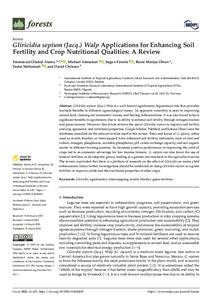| dc.contributor.author | Alamu, E.O. |
| dc.contributor.author | Adesokan, M. |
| dc.contributor.author | Fawole, S. |
| dc.contributor.author | Maziya-Dixon, B. |
| dc.contributor.author | Mehreteab, T. |
| dc.contributor.author | Chikoye, D. |
| dc.date.accessioned | 2023-03-22T10:58:25Z |
| dc.date.available | 2023-03-22T10:58:25Z |
| dc.date.issued | 2023-03-21 |
| dc.identifier.citation | Alamu, E.O., Adesokan, M., Fawole, S., Maziya-Dixon, B., Mehreteab, T. & Chikoye, D. (2023). Gliricidia sepium (Jacq.) walp applications for enhancing soil fertility and crop nutritional qualities: a review. Forests, 14, 1-13. |
| dc.identifier.uri | https://hdl.handle.net/20.500.12478/8102 |
| dc.description.abstract | Gliricidia sepium (Jacq.) Walp is a well-known agroforestry leguminous tree that provides multiple benefits in different agroecological zones. Its apparent versatility is seen in improving animal feed, cleaning environmental wastes, and healing inflammations. It was also found to have significant benefits in agroforestry due to its ability to enhance soil fertility through nitrogen fixation and green manure. However, this article reviews the use of Gliricidia sepium to improve soil fertility and crop agronomic and nutritional properties. Google Scholar, PubMed, and Science Direct were the databases consulted for the relevant articles used in this review. Trees and leaves of G. sepium, either used as mulch, biochar, or intercropped, have enhanced soil fertility indicators, such as total soil carbon, nitrogen, phosphorus, available phosphorus, pH, cation exchange capacity, and soil organic matter in different farming systems. Its immense positive performance in improving the yield of crops led to an economic advantage for low-income farmers. G. sepium can also lower the use of mineral fertilizer as its adoption grows, leading to a greener environment in the agricultural sector. The review concluded that there is a plethora of research on the effect of Gliricidia on maize yield enhancement; hence further investigations should be conducted on using Gliricidia sepium as a green fertilizer to improve yields and the nutritional properties of other crops. |
| dc.description.sponsorship | Norwegian Agency for Development Cooperation |
| dc.format.extent | 1-13 |
| dc.language.iso | en |
| dc.subject | Agronomy |
| dc.subject | Gliricidia Sepium |
| dc.subject | Soil Fertility |
| dc.subject | Animal Feeding |
| dc.subject | Agroforestry |
| dc.subject | Intercropping |
| dc.subject | Mulches |
| dc.title | Gliricidia sepium (Jacq.) walp applications for enhancing soil fertility and crop nutritional qualities: a review |
| dc.type | Journal Article |
| cg.contributor.crp | Agriculture for Nutrition and Health |
| cg.contributor.crp | Maize |
| cg.contributor.crp | Roots, Tubers and Bananas |
| cg.contributor.affiliation | International Institute of Tropical Agriculture |
| cg.contributor.affiliation | Norwegian Institute of Bioeconomy Research |
| cg.coverage.hub | Southern Africa Hub |
| cg.coverage.hub | Headquarters and Western Africa Hub |
| cg.researchtheme | Nutrition and Human Health |
| cg.isijournal | ISI Journal |
| cg.authorship.types | CGIAR and advanced research institute |
| cg.iitasubject | Agronomy |
| cg.iitasubject | Forestry |
| cg.iitasubject | Integrated Soil Fertility Management |
| cg.iitasubject | Soil Fertility |
| cg.journal | Forests |
| cg.notes | Open Access Journal; Published online: 21 Mar 2023 |
| cg.accessibilitystatus | Open Access |
| cg.reviewstatus | Peer Review |
| cg.usagerightslicense | Creative Commons Attribution 4.0 (CC BY 0.0) |
| cg.targetaudience | Scientists |
| cg.identifier.doi | https://doi.org/10.3390/f14030635 |
| cg.iitaauthor.identifier | Alamu Emmanuel Oladeji: 0000-0001-6263-1359 |
| cg.iitaauthor.identifier | Michael Adesokan: 0000-0002-1361-6408 |
| cg.iitaauthor.identifier | Segun Fawole: 0000-0001-5400-8989 |
| cg.iitaauthor.identifier | Busie Maziya-Dixon: 0000-0003-2014-2201 |
| cg.iitaauthor.identifier | David Chikoye: 0000-0002-6047-9821 |
| cg.futureupdate.required | No |
| cg.identifier.volume | 14 |

